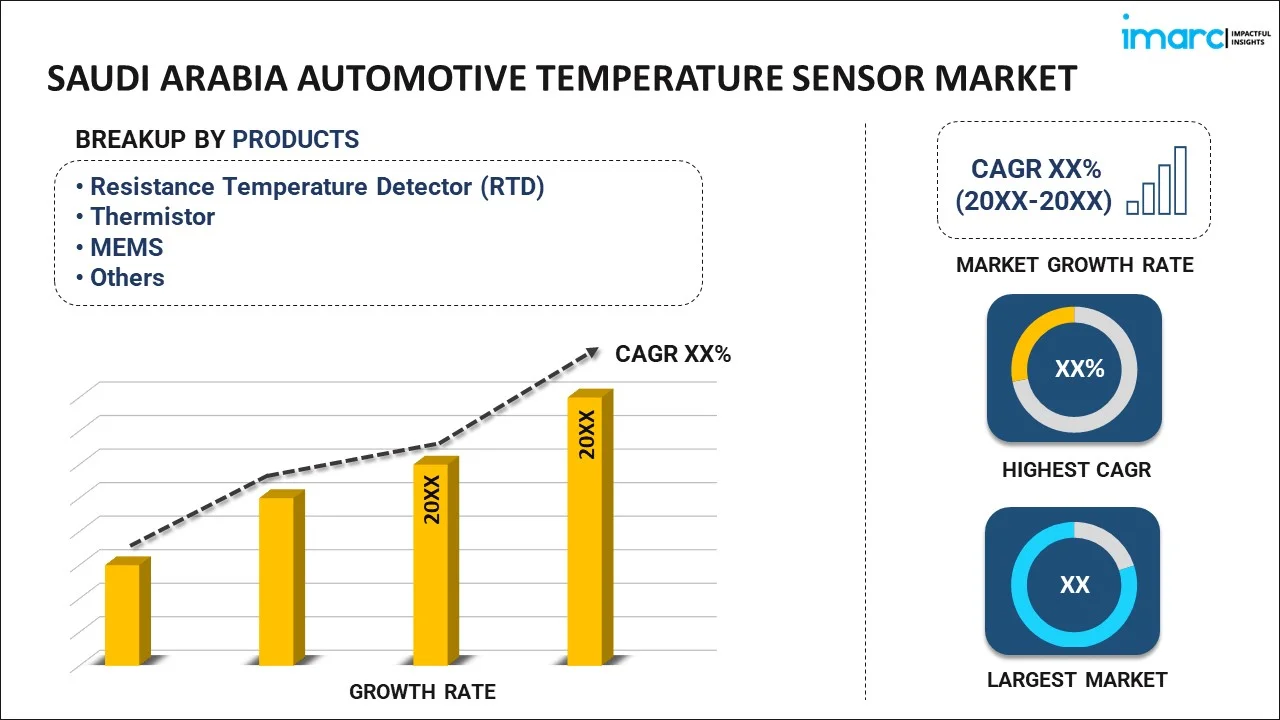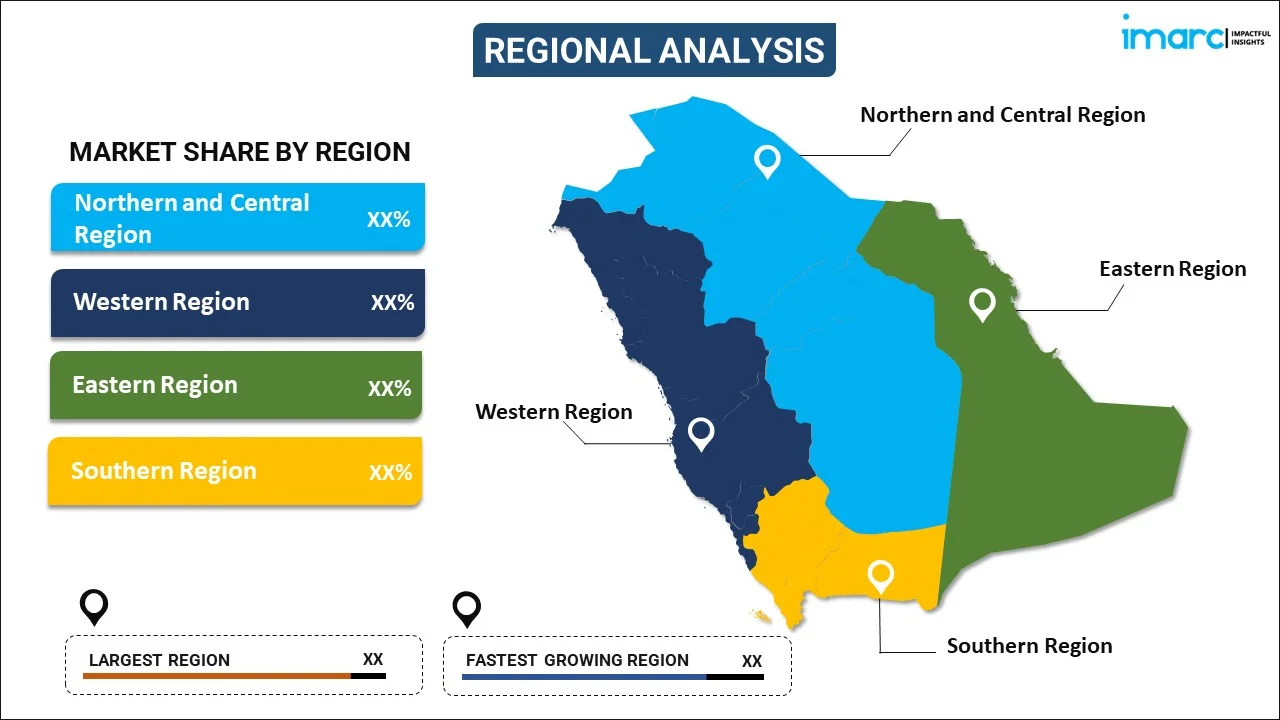
Saudi Arabia Automotive Temperature Sensor Market Report by Product (Resistance Temperature Detector (RTD), Thermistor, MEMS, IC Temperature Sensor, Thermocouple, Infrared Temperature Sensor), Technology (Contact, Non-Contact), Vehicle Type (Passenger Car, Commercial Vehicle), EV Application (HVAC, Engine, Battery, Electric Motor), and Region 2025-2033
Market Overview:
Saudi Arabia automotive temperature sensor market size reached USD 66.8 Million in 2024. Looking forward, IMARC Group expects the market to reach USD 122.0 Million by 2033, exhibiting a growth rate (CAGR) of 6.9% during 2025-2033. The rise of electric and hybrid vehicles, which has increased the demand for temperature sensors, is driving the market.
|
Report Attribute
|
Key Statistics
|
|---|---|
|
Base Year
|
2024 |
|
Forecast Years
|
2025-2033
|
|
Historical Years
|
2019-2024
|
| Market Size in 2024 | USD 66.8 Million |
| Market Forecast in 2033 | USD 122.0 Million |
| Market Growth Rate (2025-2033) | 6.9% |
An automotive temperature sensor is a crucial component in a vehicle's engine management system, designed to monitor and regulate the temperature of various engine and transmission components. Typically employing technologies like thermocouples or thermistors, these sensors measure the temperature of the coolant, oil, or other crucial fluids to ensure optimal engine performance. The data collected by these sensors is relayed to the engine control unit (ECU), allowing it to make real-time adjustments to fuel injection, ignition timing, and other parameters. This ensures that the engine operates within the desired temperature range, promoting fuel efficiency, minimizing emissions, and preventing overheating or excessive wear. Reliable temperature sensing is fundamental for maintaining engine health, enhancing overall vehicle efficiency, and contributing to the longevity of automotive systems.
Saudi Arabia Automotive Temperature Sensor Market Trends:
The automotive temperature sensor market in Saudi Arabia is experiencing robust growth, driven by several key factors. Firstly, the increasing demand for advanced driver-assistance systems (ADAS) and in-vehicle connectivity has fueled the integration of temperature sensors to monitor and regulate various automotive components. Moreover, stringent government regulations regarding emissions and fuel efficiency have mandated the use of temperature sensors in vehicles to optimize engine performance. In addition, the rising consumer awareness and emphasis on vehicle safety have led to the adoption of temperature sensors in critical areas such as engine cooling systems and exhaust systems. Furthermore, the growing trend towards electric vehicles (EVs) has significantly contributed to the expansion of the temperature sensor market, as these vehicles rely heavily on precise temperature management for battery efficiency and longevity. Additionally, the automotive industry's continuous pursuit of technological advancements, including the development of autonomous vehicles, has created a surge in the demand for temperature sensors to ensure the optimal functioning of sophisticated electronic components. The integration of Internet of Things (IoT) technologies in automotive applications has also played a pivotal role, propelling the temperature sensor market forward as vehicles become increasingly connected and require precise thermal monitoring for efficient operation. In conclusion, these interconnected drivers underscore the dynamic growth trajectory of the automotive temperature sensor market.
Saudi Arabia Automotive Temperature Sensor Market Segmentation:
IMARC Group provides an analysis of the key trends in each segment of the market, along with forecasts at the country level for 2025-2033. Our report has categorized the market based on product, technology, vehicle type, and EV application.
Product Insights:

- Resistance Temperature Detector (RTD)
- Thermistor
- MEMS
- IC Temperature Sensor
- Thermocouple
- Infrared Temperature Sensor
The report has provided a detailed breakup and analysis of the market based on the product. This includes resistance temperature detector (RTD), thermistor, MEMS, IC temperature sensor, thermocouple, and infrared temperature sensor.
Technology Insights:
- Contact
- Non-Contact
A detailed breakup and analysis of the market based on the technology have also been provided in the report. This includes contact and non-contact.
Vehicle Type Insights:
- Passenger Car
- Commercial Vehicle
The report has provided a detailed breakup and analysis of the market based on the vehicle type. This includes passenger car and commercial vehicle.
EV Application Insights:
- HVAC
- Engine
- Battery
- Electric Motor
A detailed breakup and analysis of the market based on the EV application have also been provided in the report. This includes HVAC, engine, battery, and electric motor.
Regional Insights:

- Northern and Central Region
- Western Region
- Eastern Region
- Southern Region
The report has also provided a comprehensive analysis of all the major regional markets, which include Northern and Central Region, Western Region, Eastern Region, and Southern Region.
Competitive Landscape:
The market research report has also provided a comprehensive analysis of the competitive landscape in the market. Competitive analysis such as market structure, key player positioning, top winning strategies, competitive dashboard, and company evaluation quadrant has been covered in the report. Also, detailed profiles of all major companies have been provided.
Saudi Arabia Automotive Temperature Sensor Market Report Coverage:
| Report Features | Details |
|---|---|
| Base Year of the Analysis | 2024 |
| Historical Period | 2019-2024 |
| Forecast Period | 2025-2033 |
| Units | Million USD |
| Scope of the Report | Exploration of Historical and Forecast Trends, Industry Catalysts and Challenges, Segment-Wise Historical and Predictive Market Assessment:
|
| Products Covered | Resistance Temperature Detector (RTD), Thermistor, MEMS, IC Temperature Sensor, Thermocouple, Infrared Temperature Sensor |
| Technologies Covered | Contact, Non-Contact |
| Vehicle Types Covered | Passenger Car, Commercial Vehicle |
| EV Applications Covered | HVAC, Engine, Battery, Electric Motor |
| Regions Covered | Northern and Central Region, Western Region, Eastern Region, Southern Region |
| Customization Scope | 10% Free Customization |
| Post-Sale Analyst Support | 10-12 Weeks |
| Delivery Format | PDF and Excel through Email (We can also provide the editable version of the report in PPT/Word format on special request) |
Key Questions Answered in This Report:
- How has the Saudi Arabia automotive temperature sensor market performed so far and how will it perform in the coming years?
- What has been the impact of COVID-19 on the Saudi Arabia automotive temperature sensor market?
- What is the breakup of the Saudi Arabia automotive temperature sensor market on the basis of product?
- What is the breakup of the Saudi Arabia automotive temperature sensor market on the basis of technology?
- What is the breakup of the Saudi Arabia automotive temperature sensor market on the basis of vehicle type?
- What is the breakup of the Saudi Arabia automotive temperature sensor market on the basis of EV application?
- What are the various stages in the value chain of the Saudi Arabia automotive temperature sensor market?
- What are the key driving factors and challenges in the Saudi Arabia automotive temperature sensor?
- What is the structure of the Saudi Arabia automotive temperature sensor market and who are the key players?
- What is the degree of competition in the Saudi Arabia automotive temperature sensor market?
Key Benefits for Stakeholders:
- IMARC’s industry report offers a comprehensive quantitative analysis of various market segments, historical and current market trends, market forecasts, and dynamics of the Saudi Arabia automotive temperature sensor market from 2019-2033.
- The research report provides the latest information on the market drivers, challenges, and opportunities in the Saudi Arabia automotive temperature sensor market.
- Porter's five forces analysis assist stakeholders in assessing the impact of new entrants, competitive rivalry, supplier power, buyer power, and the threat of substitution. It helps stakeholders to analyze the level of competition within the Saudi Arabia automotive temperature sensor industry and its attractiveness.
- Competitive landscape allows stakeholders to understand their competitive environment and provides an insight into the current positions of key players in the market.
Need more help?
- Speak to our experienced analysts for insights on the current market scenarios.
- Include additional segments and countries to customize the report as per your requirement.
- Gain an unparalleled competitive advantage in your domain by understanding how to utilize the report and positively impacting your operations and revenue.
- For further assistance, please connect with our analysts.
 Inquire Before Buying
Inquire Before Buying
 Speak to an Analyst
Speak to an Analyst
 Request Brochure
Request Brochure
 Request Customization
Request Customization




.webp)




.webp)












